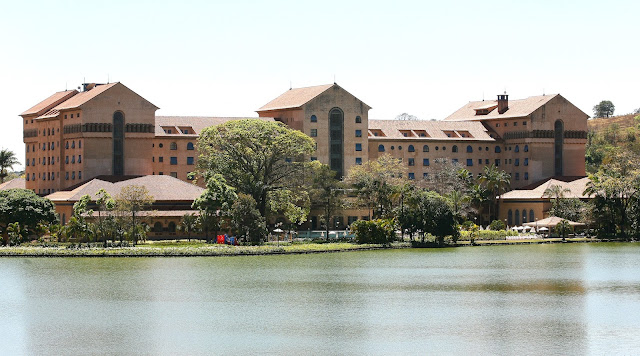Araxá , a municipality in southwest Minas Gerais state, Brazil, has some of the most tranquil holiday-maker attractions in Brazil. You will see the loveliest craft pieces made in looms, and the delicacies of the local cuisine, like compote candy and cookies. Araxá’s weather and landscapes make it perfect for exciting activities such as hang-gliding.
 |
| Photo Flickr by Jarbas Rezende |
The town was named after the Indian tribe "Araxas" who lived there at the time it was first discovered and the name means "the place from where the sun is seen first".
One of Brazil's most famous soap operas, "Dona Beja", a mythical character of the city, was filmed there (Araxá).
In addition to tourism the city has mines of niobium (columbium) used in jet engine components, rocket sub-assemblies, and heat-resisting and combustion equipment. Reserves are about 460 million tons, sufficient to satisfy current world demand for about 500 years. The largest enterprise in this sector is CBMM—Companhia Brasileira de Metallurgia e Mineração.
Araxá is a major producer of phosphate concentrate, essential for the production of fertilizers. The most important company in this sector is Vale Fertilizantes S.A., with the largest Single Super Phosphate production plant in Brazil.
The major touristic attractions of Araxa are located in Barreiro. The name "Barreiro" ("clay pit") originated from the mud left by the water of the mineral springs where the mineral salt accumulated on the rocks attracted the cattle brougth up for the first colonizers.
Araxá is famous in Brazil for its spa with medicinal mud and mineral waters. One of Brazil's most emblematic hotels, the Grand Hotel, is the center of attraction. Opened in 1944 by governor Benedito Valadares and President Vargas, the Hotel initiated an era of splendor to Araxa and the inland region of the state and it was the stage for huge social, political and cultural events.
Grand Hotel
The architecture is impressive for the magnitude of the complex, built under the Missions style influence and with approximately 33,000 m2 of built area.
The grand saloon is coated with Carrara marble, finely decorated with rich furniture and having Bohemian crystal chandeliers, French bevel-edged glass windows and masterpieces in frescos and stained glasses windows.
 |
| Grand Hotel. Photo by wikipedia |
 |
| Grand Hotel, Thermal Complex. Photo by marasenna |
Thermal Complex
The Thermal Complex is linked to the Grande Hotel by a suspended gallery decorated with frescos of landscapes of the main touristic places of Minas Gerais.
In the foyer of the main entrance there is a rotunda in stained glasses showing epic pieces of the history of Minas Gerais. On the walls around the hall the history of the colonization of Araxa is displayed and on the second floor, sustained by marble columns, the history of the several baths throughout the centuries is showed.
 |
| Photo: by aventurese |
The indoor radioactive water pool is indicated for relaxation and therapies to rehabilitate motor functions.
 |
| Indoos pool. Photo by blogdotaua |
The radioactive and sulphurous baths, in individual bathtubs, take advantage of the properties of the waters and associate the heat providing thus a relaxation of the muscles and sedating the nervous system besides improving the general blood circulation and treating the skin.
The sulphurous bath has emollient, relaxing and revitalizing properties and is indicated for embellishment and treatment of rheumatic and dermatologic troubles.
Andrade Junior Spring
One of the water springs is called Andrade Junior Spring and spurts alkaline-sulphurous water which is used in Medicine for treatment of : diabetes, obesity, gastric , rheumatologic, urological and hepatic troubles.
It is situated close to the main entrance to Barreiro.
Around the spring there is a pond where the sulphurous mud is decanted for use in the soap and cosmetic industry as well as in the health and skin treatments in the Thermal Complex.
Beside there is an exhibition of pre historic fossils found during excavations to build up the hotel.
 |
| Andrade Junior Spring. Photo by Danilo Matoso |
Dona Beja Spring
On the other side is the Dona Beja Spring , which spurts radioactive water, which bursts from volcanic rocks through drinking fountains and to the douche opposite the street, one level below. The radioactive water is good to improve the metabolism and to stimulate diuretic absorption, acting as a disintoxicating and hypotensive agent for the body.
The douche causes a healthy and reinvigorating massage.
Above the spring there is a terrace which allows a wonderful view of the whole landscape of Barreiro.
 |
| Dona Beja Spring. Photo by renatoguima |
 |
| Dona Beja Spring interior. Photo by blogdotaua |
 |
| Dona Beja Spring. Photo by aventurese |
Opposite the spring there is a handicraft fair where the locals sell pieces of crafts and typical food.
Outside the Town
Around the town there are several natural pools, cascades and waterfalls. There are also many places where one can practice trail bike, trekking, go riding on horseback and rafting.
The local tourism agencies can arrange for a guided tour to some old farms in the region.
25km away from Araxa, following the direction to Tapira, is "Morro do Horizonte Perdido" where people practice radical sports like hanggliding and paragliding and where every year professional tournments take place. Its slopes are also suitable for climbing and rappeling .
There are also tracks and waterfalls for ecological strolls and refreshing baths and dives.
In the nearby town of Sacramento there are many waterfalls, lakes and a cave and in Peiropolis, a small village close to Uberaba, there is a paleontological site displaying fossil remains and dinosaur replica.


No comments:
Post a Comment